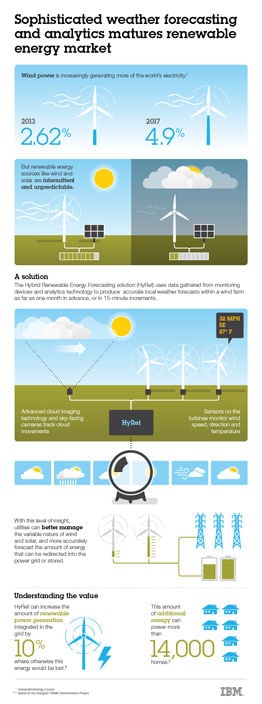This article is more than 1 year old
IBM unleashes 'big data' on wind, solar power management
Chinese megaplant adopts Big Blue's cloud tech – no, not that cloud, the ones in the sky
IBM has announced a weather-modeling and power-grid management system with the goal of increasing the effectiveness and efficiency of renewable energy sources such as wind and solar power.
"Applying analytics and harnessing big data will allow utilities to tackle the intermittent nature of renewable energy and forecast power production from solar and wind, in a way that has never been done before," IBM's global energy and utilities industry headman Brad Gammons said in a statement. "We have developed an intelligent system that combines weather and power forecasting to increase system availability and optimize power grid performance."
The system, called Hybrid Renewable Energy Forecasting, or HyRef, is part of the Smarter Energy component of IBM's Smarter Planet initiative. HyRef uses cloud-imaging tech and cameras that track cloud movement, and combines that data with info from sensors on wind turbines that keep track of wind direction, temperature, and speed. All of this data is fed into weather models and analyzed in such a way as to be able, IBM claims, to "produce accurate local weather forecasts within a wind farm as far as one month in advance, or in 15-minute increments."
By doing so, IBM says that HyRef can enable renewable-energy installations to better predict the power they can produce – wind and solar being variable sources – and thus to better anticipate the amount of power they will be able to provide to the grid to which they are connected. Such predictions enable managers to better accommodate the need to supplement renewables with such conventional power sources as coal and gas-fired power plants.

The better you can predict the weather,
the more efficient your renewables become
(click to enlarge)
HyRef builds on IBM's data analytics work with Denmark's Vestas Wind Systems, a leading provider of wind-power turbines with nearly 49,000 turbines installed in 73 countries. That effort focuses on turbine placement, and is based on what IBM calls "petabytes of data from weather reporters, tidal phases, sensors, satellite images, deforestation maps, and weather modeling research."
HyRef's weather-modeling data analytics are an outgrowth of its work on such projects as Big Blue's Deep Thunder high-resolution weather forecasting, which IBM says can help businesses and governments "tailor services, change routes and deploy equipment to minimize the effects of major weather events by reducing costs, improving service and even saving lives." [Interesting prioritization of benefits there, eh?—Ed.]
HyRef already has one major partner: China's Zhangbei National Energy Storage and Transmission Demonstration Project in the heavily industrialized Hebei Province, which combines wind and photovoltaic electricity generation with lithium-ion battery storage.
Zhangbei is currently rated at 216MW, and is scheduled to grow to 670MW as part of China's 5-year plan to cut back on its usage of fossil fuels. IBM says that adding HyRef to Zhangbei will increase its efficiency by around 10 per cent, which translates to an amount of power sufficient to provide electricity to an additional 14,000 homes – Hebei Province homes, in any case.
IBM China research analyst Meng Zhang notes that currently 20 to 40 per cent of energy from renewables can't be used because of its inherent variability. HyRef, he says, with its ability to better predict not only the output of the renewable sources but also the needs and conditions of the grid to which they are connected, can markedly increase that efficiency.
The market for wind power is expanding rapidly, IBM says, with wind now providing over 2.6 per cent of global electricity, and is projected to rise to 4.9 per cent by 2017. IBM clearly wants to be a major resource-management player in a market it projects to total $109.8bn by that latter date.
The Chinese government, faced with horrendous air-pollution problems, recently pledged $277bn toward an initiative aimed at improving air quality in and around Beijing and the adjacent Hebei Province – site of the Zhangbei complex that's implementing IBM's HyRef. ®
